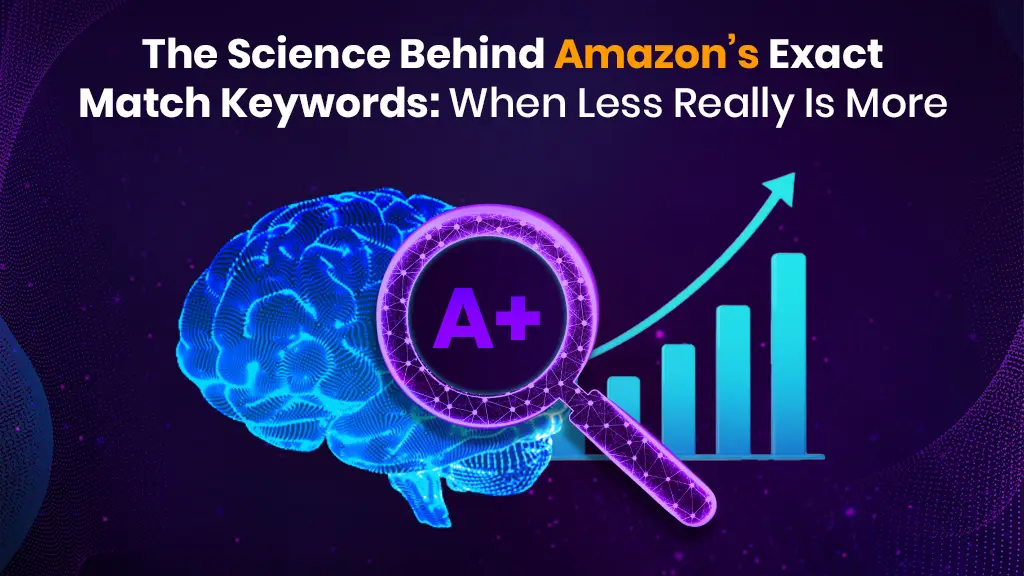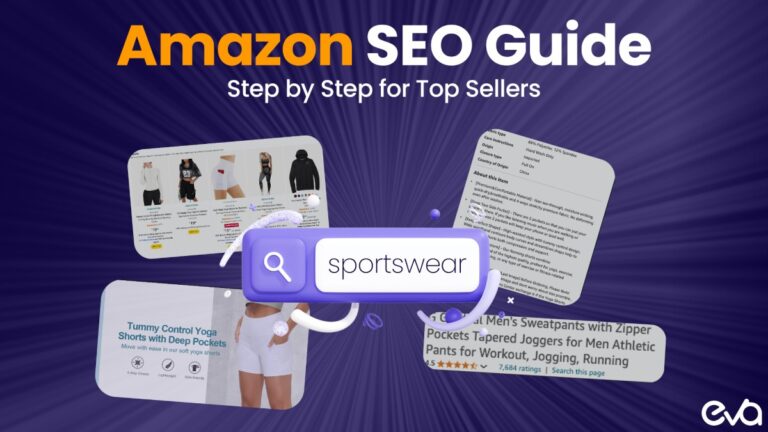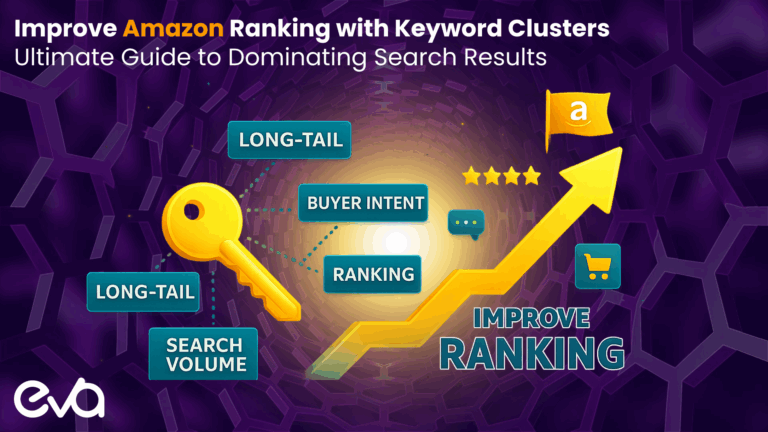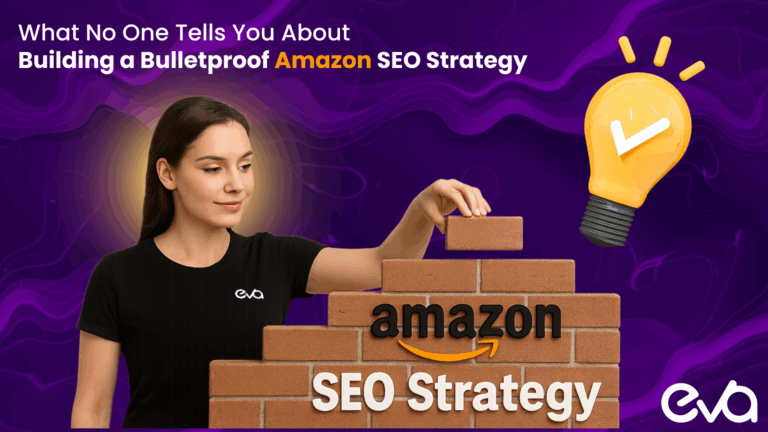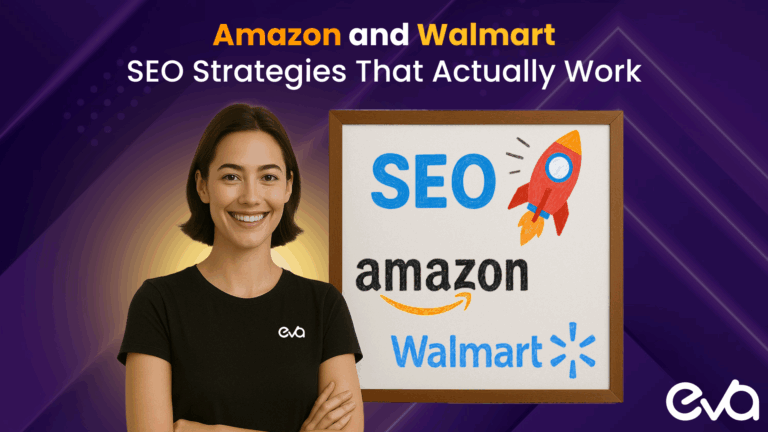Table of Contents
- The Precision Advantage in Amazon Advertising
- Decoding Amazon’s Match Type System
- How Amazon’s A9 Algorithm Rewards Precision
- Real Performance Metrics from the Field
- The Eva Implementation Framework
- Advanced Optimization for A9 Success
- Common Failures and Field-Tested Solutions
- Strategic Portfolio Balance for Algorithmic Optimization
- Measuring Success Beyond Surface Metrics
- The Path Forward with A9
- Frequently Asked Questions
The Precision Advantage in Amazon Advertising
In our work optimizing over $1.6 billion in ad spend, we’ve learned that the sellers chasing maximum impressions often generate the least profit. The campaigns that consistently deliver the highest returns focus on precision over volume.
Here’s what the data reveals: Well-managed Exact Match keywords deliver conversion rates 50-80% higher than Broad Match, with typical ACoS improvements of 20-35%. But these metrics only scratch the surface of what’s happening algorithmically.
Amazon’s A9 algorithm creates compound advantages for precision targeting. When Exact Match keywords drive consistent conversions, the A9 recognizes the relevance pattern. Quality Scores improve. CPCs trend downward. Organic rankings gradually climb. We see this progression repeatedly—focused targeting creates momentum that extends well beyond immediate sales.
Decoding Amazon’s Match Type System
The Three-Tier Targeting Framework
Amazon structures keyword targeting across three distinct match types, each serving a specific purpose in your campaign architecture:
Broad Match: The Discovery Tool
- Captures searches containing your keywords in any order
- Includes related terms, synonyms, and variations
- Example: “running shoes” matches “athletic footwear for jogging”
- Best for: Mining customer search language and discovering opportunities
Phrase Match: The Refinement Layer
- Requires your exact phrase in order, allows words before/after
- Example: “dog leash” matches “retractable dog leash” but not “leash for dogs”
- Best for: Testing specific phrases while maintaining flexibility
Exact Match: The Profit Driver
- Triggers only for your exact keyword or close variants
- Includes plurals, common misspellings, and minor variations
- Example: [coffee maker] matches “coffee maker,” “coffee makers,” and “coffe maker”
- Best for: Maximizing profitability on proven search terms
Understanding Close Variants on Amazon
Amazon’s interpretation of “close variants” for Exact Match includes:
- Singular/plural forms (“shoe” and “shoes”)
- Common misspellings (“cofee” for “coffee”)
- Punctuation differences (“dont” and “don’t”)
But explicitly excludes:
- Word reordering (“maker coffee” won’t match [coffee maker])
- Synonyms (“coffee brewer” won’t match [coffee maker])
- Additional words (“best coffee maker” won’t match [coffee maker])
This controlled flexibility helps capture real buyer intent while maintaining precision.
How Amazon’s A9 Algorithm Rewards Precision
Understanding Transactional Focus
Amazon’s A9 algorithm operates fundamentally differently from information-focused search engines. While Google optimizes for content relevance and user engagement, A9 has one primary directive: maximize purchase probability.
Core A9 Ranking Factors:
- Sales Velocity: Recent and historical sales performance
- Conversion Rate: Percentage of clicks resulting in purchases
- Keyword Relevance: Match between search terms and product attributes
- Click-Through Rate: Engagement with your listing in search results
- Price Competitiveness: Value proposition relative to alternatives
- Availability: Consistent in-stock status (FBA products get preference)
- Product Listing Quality: Completeness and optimization of content
- Customer Satisfaction: Reviews, ratings, and return rates
How Amazon’s Algorithm Interprets Match Type Signals
Amazon’s algorithm doesn’t just match keywords—it calculates purchase probability for every search-product combination. Exact Match keywords eliminate interpretive ambiguity.
Consider this scenario: A customer searches [stainless steel water bottle 32 oz]. When you target that exact phrase:
- The algorithm knows with high confidence your product matches their intent
- The A9 assigns maximum relevance weight
- Your ad competes primarily on performance metrics, not relevance guessing
This clarity creates algorithmic advantages:
- Higher Quality Scores from improved CTR (typically 0.8-1.2% vs 0.34% average)
- Preferential organic ranking consideration from consistent conversions
- Buy Box algorithm benefits from relevance signals
- Declining CPCs as A9 rewards performance
The Performance Feedback Loop
We’ve observed this pattern consistently:
- Month 1: Exact Match keywords show higher CTR
- Month 2: Improved Quality Score reduces CPCs by 10-20%
- Month 3: Organic rankings begin improving for targeted terms
- Month 4+: Reduced PPC dependency as organic traffic increases
One home goods brand experienced this firsthand: After concentrating 65% of budget on 30 Exact Match keywords, their average CPC dropped from $1.52 to $1.08 over four months. More importantly, organic sales for those keywords increased 40%, reducing overall advertising dependency.
Real Performance Metrics from the Field
ACoS: The Efficiency Reality
Based on aggregated client data from 2024:
- Broad Match ACoS: 28-38% (varies by category)
- Phrase Match ACoS: 20-30%
- Exact Match ACoS: 12-22%
Why such dramatic differences? Every Exact Match click represents someone who typed precisely what you’re selling. No exploratory shoppers. No comparison browsers. Just buyers with clear intent.
Conversion Rate: Where Profit Multiplies
Current Amazon benchmarks show:
- Platform Average: 9-10% (per Amazon’s reported data)
- Well-Optimized Exact Match: 15-20%
- Top Performers: 22-28% (typically brand + product combinations)
These aren’t incremental improvements. When conversion rates double, unit economics transform entirely. You can afford premium placement while maintaining healthy margins.
Cost Per Click: The Long-Term Advantage
Current average Amazon CPC: $1.04 (2025 data)
But here’s the pattern we see repeatedly:
- Initial Exact Match CPCs: 20-30% above Broad Match
- After 60 days: CPCs equalize due to Quality Score improvements
- After 120 days: Exact Match CPCs often 10-15% below Broad Match
This progression occurs because the A9 rewards relevance and performance over time.
The Eva Implementation Framework
Phase 1: Data Discovery (Days 1-30)
Never guess your Exact Match keywords. Let customers tell you:
- Automatic Campaigns (25% of test budget)
- Enable all targeting types
- Set conservative bids
- Mine search term reports every 48 hours
- Broad Match Discovery (40% of test budget)
- Target category-level terms
- Use suggested bid minus 20%
- Focus on impression share over efficiency
- Documentation Discipline
- Export search term reports bi-weekly
- Highlight terms with 2+ conversions
- Note exact customer phrasing (critical for Exact Match)
Phase 2: Strategic Keyword Graduation (Days 31-60)
Move proven performers to Exact Match campaigns:
Graduation Requirements:
- Minimum 3 conversions at profitable ACoS
- Consistent search volume (5+ searches weekly)
- Clear product-search alignment
- No brand confusion in search terms
Implementation Steps:
- Create dedicated Exact Match campaigns
- Set bids 25-35% above discovery campaigns
- Add graduated terms as negative exact in source campaigns
- Monitor hourly for first 48 hours (cannibalization check)
Phase 3: Single Keyword Ad Groups (Day 61+)
For keywords generating $500+ monthly revenue:
Campaign: [Brand] – Hero Products – Exact
└── Ad Group: [bamboo cutting board] – EM
└── Keyword: [bamboo cutting board]
└── Initial Bid: $1.45
└── Placement Adjustment: Top +60%
Why This Structure Works:
- Perfect performance attribution
- Granular bid optimization
- Clean A/B testing capability
- Maximum A9 relevance signals
Phase 4: Precision Negative Keywords
Even Exact Match campaigns need negatives. A9’s close variants can include unwanted variations:
Common Necessary Negatives:
- Accessories when selling main products
- Repair/replacement/parts variations
- Competitor brand combinations
- Different size/color specifications
Weekly review protocol: Check search terms, add negatives immediately, no exceptions.
Advanced Optimization for A9 Success
Dynamic Bidding Strategies by Keyword Age
New Exact Keywords (Days 1-14): Fixed bids only
- Establish clean baseline metrics
- Avoid algorithmic volatility
- Understand true conversion potential
Maturing Keywords (Days 15-60): Dynamic down only
- Protect against wasteful clicks
- Maintain stable ACoS
- Build performance history
Proven Performers (Day 61+): Dynamic up and down
- Maximize high-intent opportunities
- A9 optimization fully engaged
- Monitor for unusual spikes daily
Placement Optimization for Maximum A9 Impact
Your highest-converting keywords deserve premium visibility:
- Top of Search (Desktop): +50-80% adjustment
- Top of Search (Mobile): +40-60% (mobile converts differently)
- Product Pages: +20-40% for conquest campaigns
- Rest of Search: Base bid sufficient
Real data: A kitchen brand applied +70% Top of Search adjustment to their top 15 Exact Match keywords. Result: 52% sales increase with only 23% higher spend. Amazon’s algorithm rewarded the relevance with improved organic rankings within 90 days.
The Maximum Profitable Bid Formula
Calculate scientifically, not emotionally:
Maximum Bid = (Selling Price – COGS – Amazon Fees) × Target Profit % × Conversion Rate
Example:
- Selling Price: $40
- All-in Cost: $20
- Target Profit: 25% of revenue ($10)
- Exact Match Conversion Rate: 18%
Maximum Bid = $10 × 0.18 = $1.80
This ensures profitability even at full bid amount.
Common Failures and Field-Tested Solutions
“My Exact Match CPCs Are Killing Me”
Diagnosis: Usually targeting overly competitive terms.
Case Example: A pet supplies brand targeted [dog leash] at $2.80 CPC with 7% conversion. Research revealed customers actually searched [retractable dog leash 16 ft]. New CPC: $0.95. Conversion rate: 19%.
Solution: Mine your actual converting search terms. Don’t assume—verify through data.
“I’m Not Getting Enough Volume”
Reality Check: Exact Match isn’t about volume—it’s about profitable volume.
Case Example: A supplement brand generated “only” 400 orders/month from 40 Exact Match keywords. But those orders had 14% ACoS versus 32% for Broad Match. Profit per order was 3.5x higher.
Solution: Measure contribution margin, not vanity metrics. 100 profitable sales beat 1,000 break-even sales.
“The Algorithm Isn’t Improving My Organic Rankings”
Reality: The A9 requires sustained signals over time.
What We Typically See:
- Days 1-30: Improved paid placement only
- Days 31-90: Early organic movement (positions 20→15)
- Days 91-180: Significant improvement (positions 15→7)
- Day 180+: Stable top 10 positions for many keywords
Solution: Consistency over intensity. Maintain performance for 6+ months. Amazon’s algorithm is conservative—it wants proof of sustained relevance.
Strategic Portfolio Balance for Algorithmic Optimization
Structure your portfolio to feed A9’s algorithm:
Discovery Layer (20-30%):
- Automatic campaigns
- Broad match exploration
- New product launches
- Seasonal term testing
Refinement Layer (25-35%):
- Phrase match campaigns
- Emerging exact terms
- Competitor conquesting
- Category expansion
Profit Core (40-55%):
- Proven exact match keywords
- Brand defense terms
- High-LTV customer terms
- Top 20% performers
This structure evolves. New accounts might run 60% discovery initially. Mature accounts often operate at 65%+ Exact Match, feeding A9 consistent conversion signals.
Measuring Success Beyond Surface Metrics
Monthly Tracking Framework
Efficiency Indicators:
- Exact Match % of total sales
- Profit per order by match type
- TACoS trend (Total ACoS including organic)
A9 Algorithm Signals:
- Organic ranking movement for Exact keywords
- Search term impression share
- Buy Box win rate correlation
Business Health Metrics:
- Customer acquisition cost by source
- Repeat purchase rate by keyword type
- Review rate by traffic source
One electronics accessory brand discovered Exact Match customers had 35% higher lifetime value and left reviews at 2x the rate. A9 noticed too—their organic rankings improved across the board.
The Path Forward with A9
Exact Match mastery within the Amazon algorithm framework requires patience and precision. Start with systematic discovery. Graduate based on data, not assumptions. Optimize relentlessly. The sellers who commit to this process don’t just reduce ACoS—they build sustainable competitive moats that A9 reinforces over time.
At Eva, our AI analyzes millions of search term data points daily, identifying graduation opportunities and optimization potential human analysis might miss. But whether you’re optimizing manually or leveraging automation, the principle remains unchanged: A9 rewards precision that leads to purchases.
The marketplace belongs to sellers who understand this truth: your most profitable customers are searching for exactly what you sell. The question isn’t whether to prioritize Exact Match keywords—it’s how quickly you can identify and dominate the precise terms that matter to both your customers and A9’s algorithm.
Ready to get started? Book a free consultation today and let’s talk about how we can bring your e-commerce brand to the next levelI.
Frequently Asked Questions
Amazon has never officially announced an “A10” algorithm. While the algorithm continuously evolves with AI enhancements and new ranking factors, the core system remains A9. We focus on A9 because that’s the actual, documented algorithm powering Amazon’s search. The supposed “A10” changes are really just A9 evolving to include factors like external traffic and seller authority—which A9 has actually considered in various forms for years.
Absolutely not. You can’t know how customers search for your product until they tell you. Start with 70% automatic/broad match for 3-4 weeks. We learned this lesson with a camping gear brand who insisted on targeting [camping tent]. After proper discovery, we found customers actually searched [2 person waterproof camping tent] and [backpacking tent ultralight]. Starting with assumed Exact Match keywords wastes money and misses opportunities.
Start with 25-35% higher bids for Exact Match. If your Broad Match bid is $0.80, test $1.00-1.08 for Exact Match. The higher conversion rates justify premium bids. We’ve managed profitable campaigns with Exact Match bids 100% higher than Broad—when conversion rates are 3x better, the math works. Always calculate your break-even bid first using the formula in this guide.
Yes, Amazon includes common misspellings in Exact Match close variants. [coffee maker] will match searches for “coffe maker” and “cofee maker.” However, A9 won’t match reordered words (“maker coffee”) or synonyms (“coffee brewer”). This is more inclusive than many sellers realize but still maintains precision for purchase intent.
For well-optimized listings: 15-20% on Exact Match versus 9-10% platform average. Below 12%? Either your listing needs work or the keyword isn’t as relevant as data suggested. Category matters—supplements might see 25% while electronics hover around 15%. Price point affects conversion too. Track your specific baseline and improve from there.
Focus on quality. Most successful products have 20-40 highly relevant Exact Match keywords driving 70-80% of profitable sales. We’ve seen accounts with 200+ Exact Match keywords per ASIN, but typically only 15-20% generate meaningful volume. Start with your top 20 performers and expand gradually. Better to dominate 20 keywords than barely rank for 200.
Only for keywords generating $500+ monthly revenue with consistent performance. SKAGs require significant management—individual bid adjustments, placement modifications, budget monitoring. We tested SKAGs across all keywords for one brand and found 80% of the benefit came from the top 20% of keywords. Focus your effort where it matters most.
Data, not intuition. Requirements: minimum 3 conversions, profitable ACoS (your target or better), consistent search volume (5+ weekly searches), and exact product relevance. Don’t graduate after one good week—wait for patterns. Also verify the exact search term. We’ve seen “bamboo cutting board” convert well but actually drive sales for “bamboo cutting board with juice groove”—different products need different keywords.
A9 moves slowly but steadily. Typical timeline: Month 1-2 sees improved paid rankings only. Month 3-4 brings initial organic movement (positions 25→18). Month 5-6 shows significant improvement (positions 18→8). Sustained performance over 6+ months often achieves top 5 organic positions. A9 values consistency over intensity—maintain steady sales velocity rather than sporadic spikes.
Treating it as “set and forget.” Search behavior evolves constantly. Keywords converting last quarter might be dead today. Review performance monthly. Pause underperformers (below 10% conversion or unprofitable ACoS for 30 days). Add new graduates from discovery campaigns. One client lost $50K over six months from zombie Exact Match keywords they never reviewed. Active management is non-negotiable.
Yes, if they’re profitable and relevant. A keyword with 40 searches/month converting at 20% generates 8 sales. At $35 average order value, that’s $280 revenue from one “low-volume” keyword. Stack 30 of these and you’ve built $8,400 monthly revenue. Plus, competition is minimal, CPCs are lower, and A9 still rewards the relevance. Volume isn’t everything—profit is.
A9 factors placement into its relevance calculations. Apply +50-80% Top of Search adjustments for proven Exact Match keywords. When someone types your exact keyword, they have purchase intent—be visible. Yes, CPCs increase, but conversion rates often double in top positions. One toy brand saw 3.2x ROAS on Top of Search versus Rest of Search for their Exact Match keywords. A9 noticed the performance and improved their organic rankings accordingly.
Not without investigation. First, check conversion rate—high ACoS with 20% conversion might just need a bid reduction. Verify pricing competitiveness. Check search term report for unwanted close variants (add as negatives). Analyze placement performance—maybe only Top of Search is unprofitable. We saved a brand $30K annually by optimizing instead of pausing their “failing” Exact Match keywords. Diagnose before you amputate.

